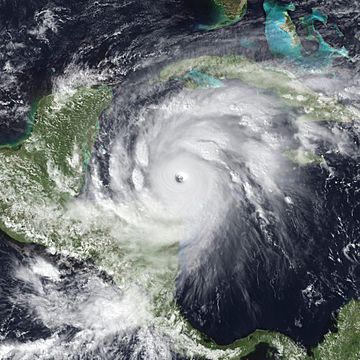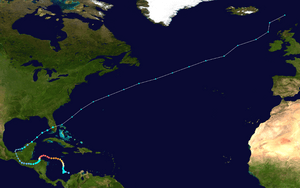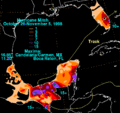Hurricane Mitch facts for kids
| Category 5 major hurricane (SSHWS/NWS) | |

Hurricane Mitch at peak intensity just to the northeast of Honduras on October 26
|
|
| Formed | October 22, 1998 |
|---|---|
| Dissipated | November 9, 1998 |
| (Extratropical after November 5) | |
| Highest winds | 1-minute sustained: 180 mph (285 km/h) |
| Lowest pressure | 905 mbar (hPa); 26.72 inHg |
| Fatalities | ≥ 11,374 total (Second-deadliest Atlantic hurricane on record) |
| Damage | $6.08 billion (1998 USD) |
| Areas affected | Central America (particularly Honduras and Nicaragua), Yucatán Peninsula, South Florida, Jamaica, Ireland, United Kingdom |
| Part of the 1998 Atlantic hurricane season | |
Hurricane Mitch was an incredibly powerful storm in 1998. It became one of the strongest hurricanes ever seen in the Atlantic Ocean. Mitch caused huge damage and led to many deaths, making it the second deadliest Atlantic hurricane on record.
This powerful storm caused over $5 billion in damage. It also led to the loss of between 11,000 and 18,000 lives, mostly in Central America and Mexico. Because of its terrible impact, the name Mitch was retired. This means it will never be used again for a hurricane in the Atlantic Ocean.
Contents
How Hurricane Mitch Formed and Moved
Hurricane Mitch started as a "tropical wave" on October 10. This is like a ripple in the atmosphere. It moved off the coast of Africa. The conditions weren't right for it to grow stronger at first.
But on October 22, the weather changed. The tropical wave grew into a "Tropical Depression Thirteen." This is the first stage of a tropical storm. The next day, October 23, it got stronger and became "Tropical Storm Mitch." It made a small loop and then turned north.
Mitch Becomes a Major Hurricane
Tropical Storm Mitch kept getting stronger. On October 24, it officially became "Hurricane Mitch." It then turned west. Mitch grew very quickly and reached its strongest point on October 26. Its top winds were an amazing 180 miles per hour! This made it a Category 5 hurricane, the strongest type. Mitch stayed a Category 5 storm and then turned south.
Weakening and Landfall
Mitch began to weaken on October 27. By October 29, it was only a Category 1 hurricane. On that same day, Hurricane Mitch made "landfall" in Honduras. Its winds were about 80 miles per hour when it hit land.
After hitting Honduras, Mitch quickly weakened into a tropical storm. It moved very slowly, almost stopping over Honduras. This slow movement caused a lot of rain. Tropical Storm Mitch then weakened even more, becoming a tropical depression as it moved into Guatemala.
Mitch's Journey Continues
As Tropical Depression Mitch entered Mexico, it weakened into a "remnant low." This means it was no longer a tropical storm or depression. However, its leftover energy moved into the Bay of Campeche. Surprisingly, it became Tropical Storm Mitch again on November 3!
Mitch then moved northeast and made landfall again in the Yucatán Peninsula. It weakened back into a tropical depression over the Yucatán Peninsula. Once Tropical Depression Mitch reached the Gulf of Mexico, it became Tropical Storm Mitch once more. It continued northeast and made its final landfall in Naples, Florida on November 5. At this point, it was a tropical storm with winds of 65 miles per hour.
After crossing Florida, Mitch changed into an "extratropical" storm. This means it lost its tropical features. The last signs of the storm were seen on November 9, north of Great Britain.
Impact of Hurricane Mitch
| Region | Direct deaths | Damage |
|---|---|---|
| Panama | 3 | Unknown |
| Costa Rica | 7 | $92 million |
| Jamaica | 3 | Unknown |
| Nicaragua | 3,800 | $1 billion |
| Honduras | 7,000 | $3.8 billion |
| Guatemala | 268 | $748 million |
| El Salvador | 240 | $400 million |
| Belize | 11 | Unknown |
| Mexico | 9 | Unknown |
| United States | 2 | $40 million |
| Offshore | 31 | N/A |
| Total | ~11,374 | $6 billion |
Many countries in Central America experienced record-breaking amounts of rainfall from Hurricane Mitch.
Honduras: The Hardest Hit
Honduras was the country most affected by Hurricane Mitch. The storm caused about 7,000 deaths and $3.8 billion in damage there. Some areas in Honduras may have received up to 75 inches of rain!
Mitch severely damaged crops in Honduras. It destroyed 58% of the corn crop and 24% of sorghum. Also, 14% of rice and 6% of the bean crop were lost. For other important crops, 85% of bananas and 60% of sugar cane were ruined. About 29% of melons, 28% of African palms, and 18% of coffee were also destroyed. The damage to crops alone in Honduras was estimated at $900 million.
Nicaragua: Mudslides and Homelessness
In Nicaragua, rainfall might have reached 50 inches. The heavy rains caused a volcano to trigger a massive mudslide. This mudslide covered an area 10 miles long and 5 miles wide.
Hurricane Mitch left between 500,000 and 800,000 people without homes. The total damage in Nicaragua was about $1 billion. Sadly, at least 3,800 people lost their lives in Nicaragua.
Florida: Impact in the United States
In the United States, only Florida was affected by Mitch. The storm damaged buildings in the Florida Keys that were already weakened by Hurricane Georges. Mitch caused about $40 million in damage in Florida. Two people also lost their lives there.
Other Affected Areas
Hurricane Mitch brought rain as far south as Panama, where three people died. Offshore in the Caribbean Sea, a boat sank, and 31 people lost their lives.
In Costa Rica, about 4,000 people became homeless due to Hurricane Mitch. Mudslides caused by the storm affected nearly 800 miles of roads. Costa Rica saw $92 million in damage, and seven people died.
In El Salvador, the flooding from Mitch destroyed 37% of the bean production. It also ruined 19% of the corn production and 20% of the sugar cane. Hurricane Mitch also caused the loss of 10,000 cattle. The damage in El Salvador was about $400 million, and 240 people died.
In Guatemala, Hurricane Mitch destroyed 6,000 houses and damaged 20,000 others. The damage to banana and coffee exports alone was $325 million. Mitch indirectly caused a plane crash, leading to 11 deaths. The storm directly caused 268 deaths. Total damages in Guatemala were about $748 million.
In Belize, Mitch caused some crop damage and harmed many roads. The damage was not as bad as it could have been. Eleven people died in Belize, but the exact cost of the damage is unknown.
Hurricane Mitch also created waves about 7 feet high in Jamaica. Three people died there, and a house in Spanish Town was destroyed. The total damage cost is not known.
Why Hurricane Mitch's Name Was Retired
Because of the many deaths and the massive damage it caused, the name "Mitch" was officially removed and "retired." This means the name will never be used again for a storm in the Atlantic Ocean. For example, in 2004, the name Matthew was used instead of Mitch. The name Matthew can be used again in future hurricane seasons because it was not retired.
|
Tropical cyclones of the 1998 Atlantic hurricane season |
||||||||||||||||||||||||||||||
|
|
|||||||||||||||||||||||||||||
|
|
||||||||||||||||||||||||||||||
|
Images for kids
-
Damage in Tegucigalpa
-
Flooding in Lake Managua after the hurricane
-
Casita volcano in western Nicaragua after deadly mudslide
-
Cleanup in Tegucigalpa
See also
 In Spanish: Huracán Mitch para niños
In Spanish: Huracán Mitch para niños










